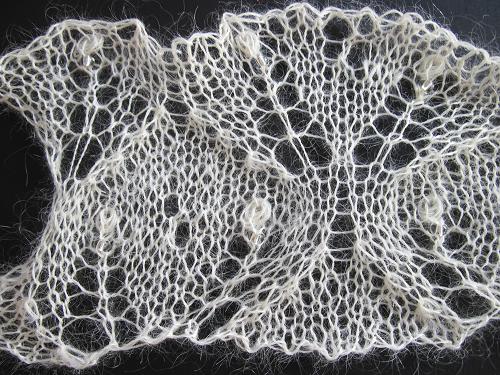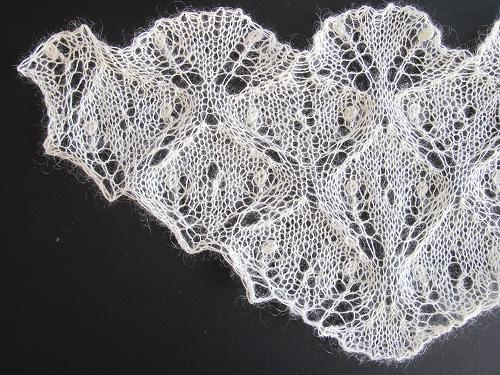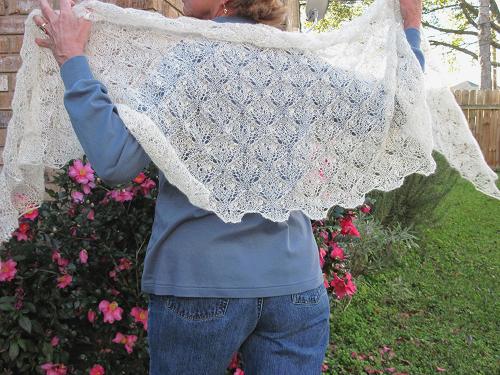I love to “paint” with color and texture in many media. Probably my favorite media and technique, not too surprisingly, are fine yarns, beads and lace knitting. The rectangular shape of a stole provides the simplest of ‘canvases’ in which to play with design.
It starts with “tell a story”. For example – Picture early morning walks on the beach and looking out over gently breaking waves through the morning haze.
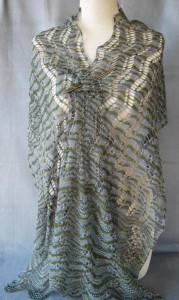
That picture-story is the basis of the design I just released at Sandrasingh.com today for Gentle Breezes. Flashback to how the story unfolded from design concept through completion of the Gentle Breezes Stole.
My design concepts can hibernate anywhere from a few days to several years (or maybe forever, because I still have LOTS more in the queue. No telling if I will live long enough to see the fruits of them all). Anyway, when Sandra Singh asked me to design something in her single ply Lace yarn, I found that she had a color that was a match made in heaven for the look and feel of that morning walk on the beach looking out over the ocean through a morning haze. Aptly named, the color of this gently variegated gray/blue/green yarn is Ocean Breeze.

I envisioned using beads to suggest the glint of sunlight off the waves. The yarn is single ply and I was concerned about the strength. So, originally I was thinking I would have to use size 6/0 seed beads, placing them using the crochet hook method on a double strand stitch loops. Fortunately, the yarn has a lot of substance and strength so that I could use the smaller size 8/0 seed beads to give the subtler look I originally was after. The strength of the yarn comes partially from it having a slight felted texture. The smaller beads will be pre-strung on the single strand of yarn and slid into place where needed as the knitting progresses.
The next step in the design process was to select a bead color. I narrow the selection to a few finalists based on bead color availability (I prefer the Miyuki brand) and my experience in selecting bead colors. I don’t think the various colors of the beads show up very well in the photo, but this is how I go about choosing the “winner” from the finalists (in this case there were 9 colors I was considering in the final running). By sliding a few of each bead color onto the yarn and seeing them against the yarn (rather than just isolated in a whole bag of beads of the same color) is more representative of what they will actually look like when incorporated into the knitted fabric.
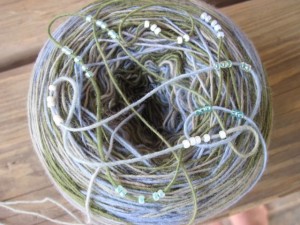
Out of the 9 bead color finalists, I decided on Turquoise Ceylon #536. Several of the others would have been lovely as well. It’s always a hard choice — I love them all!
For the knitted fabric, I planned that the ends of the stole would be worked separately and done in a wide beaded lace border reminiscent of breaking waves. Then the main area of the stole between the 2 wide border ends would be an unbeaded lace stitch pattern giving the feel of breezes and the gentle swells of the ocean.
Up to this point I had still been toying with titles for the design. I settled on “Gentle Breezes”, as I felt this gave more flexibility in knitters choosing the yarn and bead colors to match the picture story wherever they might imagine of gentle breezes on a morning or evening walk.
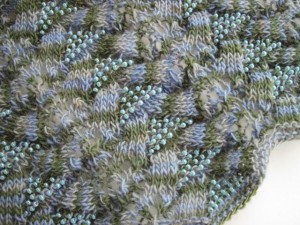
I found the Sandrasingh.com yarn really pleasant to work with. Even though it is a single ply, it is not kinky at all. And I’ve not had any trouble, either, in it holding up to being strung with the beads. The slightly felted texture of the yarn not only gives it strength, but a wonderful softness plus a lot of volume for its weight.
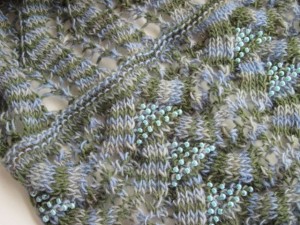
The knitting proceeded quickly. Of course, in these photos of knitting in progress, the lace knitting has not yet been blocked, so it still looks crumpled and messy. Once blocked, the design elements will “pop” and look crisper/more distinct. In this picture of knitting in progress, the 1st border (in the upper part of the picture) is just lying under the 2nd piece. The two pieces will be grafted together later for an invisible join.
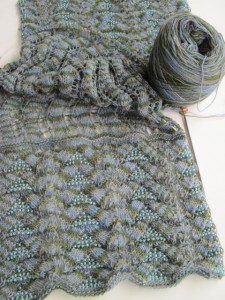
After completing the knitting and grafting the 2 pieces together, the stole is tension blocked.

I never tire of that magic moment when lace is blocked out to show all of its airy beauty. The completely dried stole is then released from the blocking wires and pins, and my senses are further delighted in the wonderful drape and hand of the sheer knitted fabric.
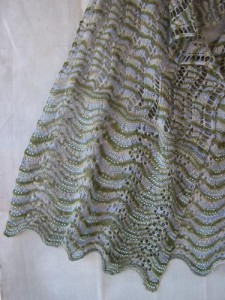
And the story has a happy ending — or is it just the beginning? I hope you might be inspired to “paint” your own picture story using my Gentle Breezes pattern as a jumping off point in creative knitting art.



